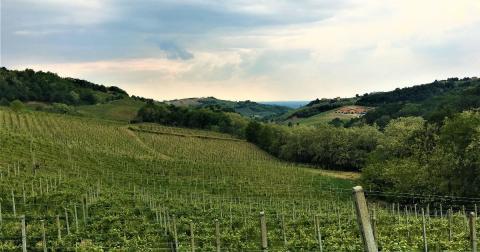Il nonno Giuseppe con i suoi fratelli Lino e Paolo nel dopo guerra iniziarono a coltivare i vigneti lasciati da loro padre Italo. Inizialmente la maggior parte delle uve veniva venduta e solo una piccola parte destinata alla vinificazione. Dopo pochi anni, indicativamente nel 1960, le vendite si fecero più elevate e tutta la produzione fu destinata alla vinificazione. Il canale di vendita era il vino sfuso venduto nelle classiche damigiane.
Nel 1970 scelsero di dividersi e rimase solo il nonno Giuseppe a condurre i terreni, furono venduti tutti gli altri terreni, tranne le vigne limitrofe al castello, dove attualmente vengono prodotte le due etichette "Vigna Rondinella" e "Venti Pertiche".
I Principi cardine su cui baso la mia viticoltura sono:
● Tutela della bio-diversità e dell'ambiente
● Inerbimento con specie autoctone
● Rispetto del suolo
Gestisco il vigneto con una filosofia ed una rielaborazione critica dei concetti, diminuendo al minimo l'impatto ambientale, studiando i processi in modo olistico e valutando parametri come: le emissioni di CO2, la fito tossicità del rame, il compattamento del terreno, la sanità delle uve e i conseguenti minor trattamenti da adottare in cantina.
La superficie ridotta dei vigneti pari a 3 ha, con una produzione teorica di 20000 bot, è stata calcolata per avere il pieno controllo sulla produzione, producendo uve selezionatissime. Viene praticato l'inerbimento totale del vigneto abbinato ad una lavorazione minima del terreno che viene eseguita ogni 4 anni a filari alterni. La lavorazione consiste in un passaggio con il ripper*1 dopo la vendemmia ed una fresatura*2 in primavera, permettendo al terreno di arieggiarsi, integrare le sostanze organiche e evitare i compattamenti del suolo. Le rese per ettaro sono contenute e si aggirano attorno a 75 q / 85 q, ottenendo delle uve che non necessitano correzioni in cantina.
La bio-diversità è tutelata non solo con pratiche agronomiche nel vigneto, ma proteggendo una superficie boschiva pari al 50% dell'area vitata. L'appezzamento di bosco più esteso pari quasi a 10000 m2, si trova adiacente ai vigneti. Quest'ultimo è un habitat capace d'offrire protezione alla fauna composta da: caprioli, lepri, tassi, istrici, cinghiali, falchi, volpi e molti altri animali.
Non meno importante è la compensazione totale della CO2, producendo ad impatto zero. La superficie boschiva assorbe completamente l'anidride carbonica emessa dalle operazioni agronomiche e dai processi fermentativi dei mosti.
L'inerbimento del vigneto con specie autoctone viene sfruttato in sinergia con l'habitat boschivo prolungandolo al suo interno. Creando un prato con più periodi di fioritura dove le api possono bottinare e gli erbivori brucare l'erba.
*1 Fresatura: pratica agronomica che rimescola il terreno per i primi 15/20 cm con un attrezzo movimentato da una trattrice.
*2 Ripperatura: pratica agronomica che smuove il terreno mediante una serie di tagli verticali che arrivano a una profondità di 40 cm.








